近50年上海地区日照时数的变化特征及影响因素
近50年贵港日照时数变化特征及影响因子分析
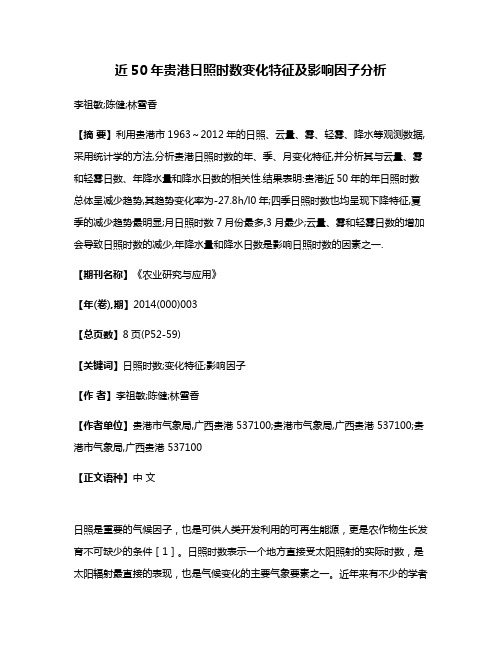
近50年贵港日照时数变化特征及影响因子分析李祖敏;陈健;林雪香【摘要】利用贵港市1963~2012年的日照、云量、雾、轻雾、降水等观测数据,采用统计学的方法,分析贵港日照时数的年、季、月变化特征,并分析其与云量、雾和轻雾日数、年降水量和降水日数的相关性.结果表明:贵港近50年的年日照时数总体呈减少趋势,其趋势变化率为-27.8h/l0年;四季日照时数也均呈现下降特征,夏季的减少趋势最明显;月日照时数7月份最多,3月最少;云量、雾和轻雾日数的增加会导致日照时数的减少,年降水量和降水日数是影响日照时数的因素之一.【期刊名称】《农业研究与应用》【年(卷),期】2014(000)003【总页数】8页(P52-59)【关键词】日照时数;变化特征;影响因子【作者】李祖敏;陈健;林雪香【作者单位】贵港市气象局,广西贵港 537100;贵港市气象局,广西贵港 537100;贵港市气象局,广西贵港 537100【正文语种】中文日照是重要的气候因子,也是可供人类开发利用的可再生能源,更是农作物生长发育不可缺少的条件[1]。
日照时数表示一个地方直接受太阳照射的实际时数,是太阳辐射最直接的表现,也是气候变化的主要气象要素之一。
近年来有不少的学者对日照时数的气候变化进行了研究。
李玉娥、李忠琦等[2]利用保定市1955~2009年的日照、云量、雾、沙尘等资料,分析了保定市近55年日照时数的变化特征及影响因子。
陈国弟、黄丽超[3]利用线性分析法,对东兴近53年来日照时数变化趋势进行分析。
贾海燕、高明等[4]研究了临汾市48年来日照时数的年、季、月变化趋势和年代变化特征,并对其影响因子进行了相关性分析。
王东、许嘉玲[5]采用统计学方法,分析了宿州市近58年日照时数的气候特征,表明宿州市的日照时数和日照百分率与总云量无明显的线性关系。
由于日照受诸多要素的影响,不同地区日照的变化特征具有明显的差异。
文章利用贵港长达50年的日照时数资料,分析贵港日照时数的气候特征、变化规律及其主要影响因子,可为当地气候变化的研究、发展生态农业及太阳能的开发利用提供科学依据。
上海地区气候特征及地质条件
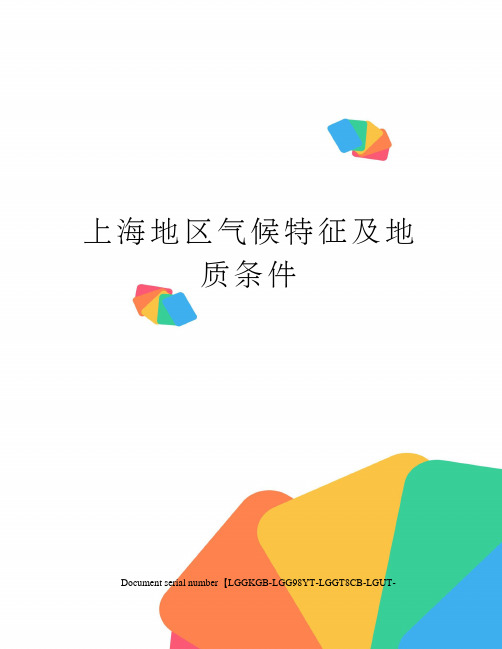
上海地区气候特征及地质条件Document serial number【LGGKGB-LGG98YT-LGGT8CB-LGUT-上海地区气候特征及地质条件上海濒江临海,属亚热带季风气候,呈现季风性、海洋性气候特征。
冬夏寒暑交替,四季分明,春秋较冬夏较长。
主要气候特征是:春天暖和,夏季炎热、秋天凉爽,冬季阴冷;全年雨量适中,年60%左右和雨量集中在5~9月的汛期,年平均降水量1119.1㎜,年蒸发量882.4㎜;年平均日照1400h。
由于上海城区面积大、人口密集,使上海城市气候具有明显的城市热岛效应。
全年平均气温15.8℃,1月最冷平均为3.6℃,7月最热为27.8℃。
上海地区夏季空调运行约4个月(6~10月初),冬季运行约3个月(12~3月初)。
上海地区具有的夏长、冬短的特点,对地下换热器长时间工作可能会引起热平衡问题。
地质条件特征上海市位于长江三角洲入海口东南前缘,面积约6340.5K㎡,成陆较晚,除西南部有高出数十米至近百米的零星残丘陵外,全区地势平坦.境内地面标高(吴淞高程)大多在3.5~4.5M之间。
地貌上整个地形呈现东高、西低形态,西部为淀泖洼地,东部为碟缘高地.上海露出地表的基岩分布零星,多呈孤丘出现,总面积约2.5K㎡,而大片的基岩隐伏在第四系松散沉积物之下。
上海地区第四纪地层十分发育,除西部、西南部剥蚀丘陵有基岩隆起出露外,其余地区均有第四纪地层覆盖,厚度一般介于200~320M之间,西南较薄,为100~250M,向东北增厚至300~400M。
按沉积相大致可划分为二部分:1)下部,埋深通常约145~320M间,以褐黄色为主,夹杂蓝灰、黄绿色网纹或杂斑的杂色粘土与灰色白色为主的砂砾互层,称之为“杂色层”,为早更新世陆相沉积物;2)上部,埋深通常指约145M以上,是以灰色为主,夹有绿、黄、褐黄等色的粘土,与浅灰、黄灰色粉砂性土互层,称为“灰色层”,属中更新世以来海陆频繁过渡、海洋渐占优势环境下的沉积物。
上海年光照数据曲线

上海年光照数据曲线
首先,上海的年光照数据曲线受到多种因素的影响。
这些因素
包括地理位置、季节变化、气候条件等等。
由于上海位于东经121度,所以其所在的地理位置决定了其日照时长的变化。
此外,上海
位于亚热带季风气候区,受到季风气候的影响,季节变化对光照时
长也有一定的影响。
其次,根据历史数据和气象统计,上海的年光照数据曲线呈现
出明显的季节性变化。
一般来说,春季和秋季的日照时长较为适中,夏季的日照时长相对较长,而冬季的日照时长相对较短。
这是因为
夏季上海受到副高的控制,天气晴朗,阳光充足,所以日照时长较长;而冬季上海受到冷空气的影响,天气阴沉,云量较多,所以日
照时长较短。
此外,上海的年光照数据曲线还受到天气变化的影响。
在晴朗
的天气下,日照时长会相对较长;而在阴雨天气或多云天气下,日
照时长会相对较短。
因此,上海的年光照数据曲线会因为天气变化
而有所波动。
另外,上海的城市发展和建筑物的高度也会对光照时长产生一
定的影响。
随着城市的不断扩大和建筑物的增多,高楼大厦会阻挡阳光的直射,导致部分地区的光照时长相对较短。
总结来说,上海的年光照数据曲线受到地理位置、季节变化、气候条件、天气变化和城市发展等多种因素的综合影响。
通过对这些因素的综合考虑,可以得出上海年光照数据曲线的全面完整的情况。
但具体的数据曲线需要根据实际的气象观测数据进行分析和统计,以获得准确的结果。
1960-2015年上海奉贤日照时数变化特征
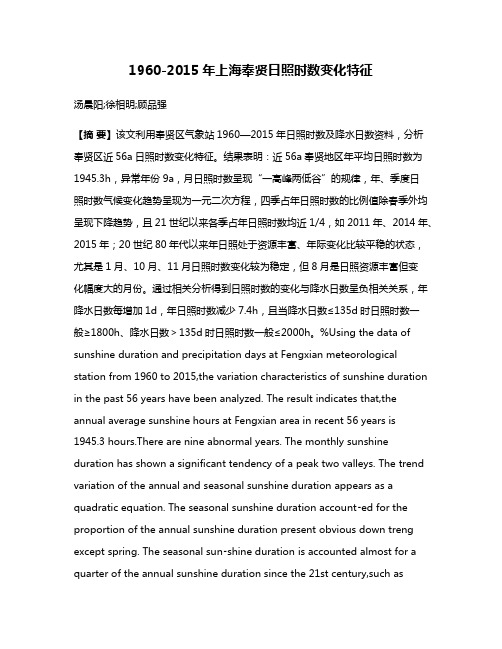
1960-2015年上海奉贤日照时数变化特征汤晨阳;徐相明;顾品强【摘要】该文利用奉贤区气象站1960—2015年日照时数及降水日数资料,分析奉贤区近56a日照时数变化特征。
结果表明:近56a奉贤地区年平均日照时数为1945.3h,异常年份9a,月日照时数呈现“一高峰两低谷”的规律,年、季度日照时数气候变化趋势呈现为一元二次方程,四季占年日照时数的比例值除春季外均呈现下降趋势,且21世纪以来各季占年日照时数均近1/4,如2011年、2014年、2015年;20世纪80年代以来年日照处于资源丰富、年际变化比较平稳的状态,尤其是1月、10月、11月日照时数变化较为稳定,但8月是日照资源丰富但变化幅度大的月份。
通过相关分析得到日照时数的变化与降水日数呈负相关关系,年降水日数每增加1d,年日照时数减少7.4h,且当降水日数≤135d时日照时数一般≥1800h、降水日数>135d时日照时数一般≤2000h。
%Using the data of sunshine duration and precipitation days at Fengxian meteorological station from 1960 to 2015,the variation characteristics of sunshine duration in the past 56 years have been analyzed. The result indicates that,the annual average sunshine hours at Fengxian area in recent 56 years is 1945.3 hours.There are nine abnormal years. The monthly sunshine duration has shown a significant tendency of a peak two valleys. The trend variation of the annual and seasonal sunshine duration appears as a quadratic equation. The seasonal sunshine duration account⁃ed for the proportion of the annual sunshine duration present obvious down treng except spring. The seasonal sun⁃shine duration is accounted almost for a quarter of the annual sunshine duration since the 21st century,such as2011,2014,2015. Since the 1980s,the annual sunshine duration is rich in resources and it’s interannual variability pr esents relatively stable state,especially as in January,October,November.But in August,there are large variations of sunshine hours. Through some relative analysis,the variation of sunshine duration is obviously negatively with pre⁃cipitation days. When annual precipitation days increase 1d per year,annual sunshine hours reduce 7.4h. When an⁃nual precipitation days are≤135d,annual sunshine hours are≥1800h generally. When annual precipitation days are>135d ,annual sunshine hours are≤2000h generally.【期刊名称】《安徽农学通报》【年(卷),期】2016(022)014【总页数】4页(P149-152)【关键词】日照时数;变化特征;降水日数【作者】汤晨阳;徐相明;顾品强【作者单位】上海市奉贤区气象局,上海 201400;上海市奉贤区气象局,上海201400; 北京师范大学地表过程与资源生态重点实验室,北京 100875;上海市奉贤区气象局,上海 201400【正文语种】中文【中图分类】P468在日常生产中,气候因子对作物物候影响明显,光照条件是重要因子之一,目前已有众多学者进行了光照对物候的影响分析,如宫恒瑞等[1]对乌昌地区近30a日照时数进行了分析,得出日照时数的变化对设施农业生产的不利影响较为明显;曹巧莲等[2]得出临汾市日照时数的减少对小麦、玉米、棉花的生长都有不利影响;李君海等[3]得出陵水县日照时数变化对农业的影响以冬季最为突出。
上海地区农业气象与变迁状况综述
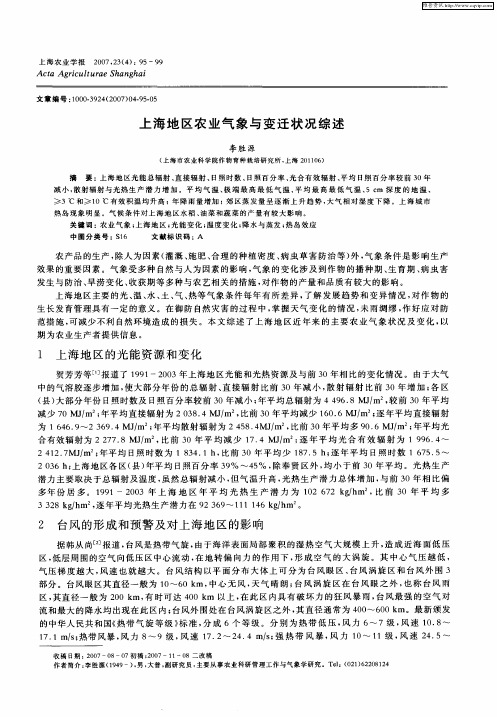
农 产 品 的生 产 , 除人 为 因素 ( 溉 、 肥 、 灌 施 合理 的种 植 密度 、 虫草 害防治 等 ) , 象 条件 是 影 响生 产 病 外 气 效 果 的重要 因素 。气 象受 多种 自然 与人 为 因素 的影响 , 象 的变 化涉 及 到作 物 的播种 期 、 育期 、 虫 害 气 生 病 发 生 与防治 、 旱涝 变 化 、 获期 等多 种与 农艺 相关 的措施 , 收 对作 物的 产量 和品 质有较 大 的影 响 。 上海地 区主要 的光 、 、 、 、 、 温 水 土 气 热等 气象 条件 每年 有 所差 异 , 了解 发 展趋 势 和 变异 情 况 , 对作 物 的 生 长 发育管 理具 有一 定 的意义 。在 御 防 自然 灾 害 的过程 中 , 掌握 天 气 变化 的情 况 , 雨 绸缪 , 好 应对 防 未 作 范措 施 , 减少 不利 自然 环境 造成 的损 失 。本文 综 述 了上海 地 区近 年来 的主 要 农 业 气 象 状 况及 变 化 , 可 以 期 为农业 生产 者提供 信 息 。
减 小 , 射 辐 射 与 光 热 生 产 潜 力 增 加 。平 均 气 温 、 端 最 高 最 低 气 温 、 均 最 高 最 低 气 温 、 m 深 度 的 地 温 、 散 极 平 5c ≥ 3℃ 和≥ 1 0℃ 有 效 积 温 均 升 高 ; 降 雨 量 增 加 ;郊 区 蒸 发 量 呈 逐 渐 上 升 趋 势 , 气 相 对 湿 度 下 降 。上 海 城 市 年 大 热 岛 现 象 明 显 。气 候 条 件 对 上 海 地 区水 稻 、 菜 和 蔬 菜 的产 量 有 较 大 影 响 。 油 关 键 词 : 业 气 象 ; 海 地 区 ; 能 变 化 ; 度变 化 ; 水 与 蒸 发 ; 岛 效 应 农 上 光 温 降 热
上海地区气候特征及地质条件及行政区域划分

Chenshan lingdai dian naoWhich Place of shanghai age family salary上海地区气候特征及地质条件上海濒江临海,属亚热带季风气候,呈现季风性、海洋性气候特征。
冬夏寒暑交替,四季分明,春秋较冬夏较长。
主要气候特征是:春天暖和,夏季炎热、秋天凉爽,冬季阴冷;全年雨量适中,年60%左右和雨量集中在5~9月的汛期,年平均降水量1119.1㎜,年蒸发量882.4㎜;年平均日照1400h。
由于上海城区面积大、人口密集,使上海城市气候具有明显的城市热岛效应。
全年平均气温15.8℃,1月最冷平均为3.6℃,7月最热为27.8℃。
上海地区夏季空调运行约4个月(6~10月初),冬季运行约3个月(12~3月初)。
上海地区具有的夏长、冬短的特点,对地下换热器长时间工作可能会引起热平衡问题。
地质条件特征上海市位于长江三角洲入海口东南前缘,面积约6340.5K㎡,成陆较晚,除西南部有高出数十米至近百米的零星残丘陵外,全区地势平坦.境内地面标高(吴淞高程)大多在 3.5~4.5M之间。
地貌上整个地形呈现东高、西低形态,西部为淀泖洼地,东部为碟缘高地.上海露出地表的基岩分布零星,多呈孤丘出现,总面积约2.5K㎡,而大片的基岩隐伏在第四系松散沉积物之下。
上海地区第四纪地层十分发育,除西部、西南部剥蚀丘陵有基岩隆起出露外,其余地区均有第四纪地层覆盖,厚度一般介于200~320M之间,西南较薄,为100~250M,向东北增厚至300~400M。
按沉积相大致可划分为二部分:1)下部,埋深通常约145~320M 间,以褐黄色为主,夹杂蓝灰、黄绿色网纹或杂斑的杂色粘土与灰色白色为主的砂砾互层,称之为“杂色层”,为早更新世陆相沉积物;2)上部,埋深通常指约145M以上,是以灰色为主,夹有绿、黄、褐黄等色的粘土,与浅灰、黄灰色粉砂性土互层,称为“灰色层”,属中更新世以来海陆频繁过渡、海洋渐占优势环境下的沉积物。
上海日照射量
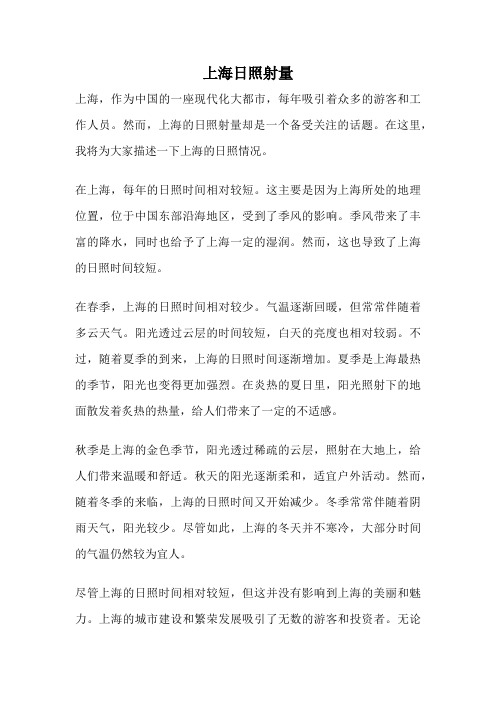
上海日照射量上海,作为中国的一座现代化大都市,每年吸引着众多的游客和工作人员。
然而,上海的日照射量却是一个备受关注的话题。
在这里,我将为大家描述一下上海的日照情况。
在上海,每年的日照时间相对较短。
这主要是因为上海所处的地理位置,位于中国东部沿海地区,受到了季风的影响。
季风带来了丰富的降水,同时也给予了上海一定的湿润。
然而,这也导致了上海的日照时间较短。
在春季,上海的日照时间相对较少。
气温逐渐回暖,但常常伴随着多云天气。
阳光透过云层的时间较短,白天的亮度也相对较弱。
不过,随着夏季的到来,上海的日照时间逐渐增加。
夏季是上海最热的季节,阳光也变得更加强烈。
在炎热的夏日里,阳光照射下的地面散发着炙热的热量,给人们带来了一定的不适感。
秋季是上海的金色季节,阳光透过稀疏的云层,照射在大地上,给人们带来温暖和舒适。
秋天的阳光逐渐柔和,适宜户外活动。
然而,随着冬季的来临,上海的日照时间又开始减少。
冬季常常伴随着阴雨天气,阳光较少。
尽管如此,上海的冬天并不寒冷,大部分时间的气温仍然较为宜人。
尽管上海的日照时间相对较短,但这并没有影响到上海的美丽和魅力。
上海的城市建设和繁荣发展吸引了无数的游客和投资者。
无论是外滩的夜景,还是东方明珠塔的壮丽,上海都展现出了自己的独特魅力。
总的来说,上海的日照量相对较少,但这并不影响人们对这座城市的热爱和追求。
阳光虽然不常见,但当它洒在大地上时,仍然能够给人们带来温暖和希望。
上海,作为一个现代化的城市,将继续吸引人们的目光,成为中国乃至世界的一颗明星。
近50年上海地区日照时数的变化特征及影响因素

测, 而与其 处 于 同一 区 的川沙 气象 站则 于 2 0 0 0年停 止 观 测 , 浦东 1 6 1 9 年 日照 时数 利用川 沙气 故 90 9 9 象 站 资料 , 而在 2 0 - 2 0 年 间利用 浦 东气象 站资 00 0 9 料 。上 述气 象 资料 都 来 自于上 海 市 气候 中心 , 都 并
季 、 季 和 冬 季 的 日照 时 数 显 著 减 少 , 季 日照 时 数 变 化 不 显 著 。1 8 秋 春 9 0年 是 上 海 日照 时 数 减 少 突变 的 时 间 点 , 日 是
照 时 数 由正 距 平 占优 势 转 为 负距 平 占优 势 的 转 折 点 。空 间 上 , 个 上 海 日照 时 数 在 过 去 5 整 O年 均 呈 减 少 趋 势 , 且 并 由北 向南 减 少 趋 势 逐 渐 减 弱 。上 海 年 日照 时数 与 降 水 量 和 降 水 日数 呈 显 著 负 相 关 , 日照 时 数 的 减 少 与 年 降 水 量 年 的 增 加 有 关 。上 海 各 季 日照 时数 与云 量 、 汽 压 和 降 水 基 本 都 呈 显 著 的 负 相 关 , 季 日照 时 数 减 少 主 要 是 由 降 水 水 夏 量 的 增 加 造 成 的 , 季 日照 时 数 的 减 少 与 水 汽 压 和 降 水 量 的增 加 有 关 。 冬 关 键 词 日照 时 数 趋势系数 Ma nK n al 验 云 量 n - e d l检 水 汽 压 降水 量
影 响到其 他气 象要 素 和地 表 通 量 的 空 间分 布 , 而 因
探讨 日照时数 的变 化具 有重 要 意义_ 。 2 ] 近 年来 , 多学 者对 当地 的 1 许 3照变 化 特 征 和成 因都 做 了较 为详细 的论 述 , 得 出较 为一致 的结 论 , 并 即各 地 日照 时数均 呈减 少 的趋 势 [ 引。上 海是 我 国 2 东部 工业 化 、 市化 和社 会 经 济 发 展 较 为迅 速 的地 城 区之 一 , 近年来 , 区域气 候变 暖 和生态 环境 快 速演 在
- 1、下载文档前请自行甄别文档内容的完整性,平台不提供额外的编辑、内容补充、找答案等附加服务。
- 2、"仅部分预览"的文档,不可在线预览部分如存在完整性等问题,可反馈申请退款(可完整预览的文档不适用该条件!)。
- 3、如文档侵犯您的权益,请联系客服反馈,我们会尽快为您处理(人工客服工作时间:9:00-18:30)。
近50年上海地区日照时数的变化特征及影响因素靳利梅【摘要】基于上海地区11个气象站1960-2009年的日照时数、云量、水汽压、降水资料,采用线性趋势分析、Mann-Kendall检验等气候统计诊断方法,分析了上海地区日照时数年际、季节的变化特征以及空间分布特征,并对影响日照时数的气候因子进行了分析.结果表明,1960-2009年期间,上海地区日照时数呈显著减少的趋势,其中夏季、秋季和冬季的日照时数显著减少,春季日照时数变化不显著.1980年是上海日照时数减少突变的时间点,是日照时数由正距平占优势转为负距平占优势的转折点.空间上,整个上海日照时数在过去50年均呈减少趋势,并且由北向南减少趋势逐渐减弱.上海年日照时数与降水量和降水日数呈显著负相关,年日照时数的减少与年降水量的增加有关.上海各季日照时数与云量、水汽压和降水基本都呈显著的负相关,夏季日照时数减少主要是由降水量的增加造成的,冬季日照时数的减少与水汽压和降水量的增加有关.%Based on the data of sunshine duration, cloud amount, surface vapor pressure, and precipitation of 11 meteorological stations in Shanghai, the temporal and spatial variation characteristics of sunshine duration and the influencing factors from 1960 to 2009 are analyzed using the linear trend, Mann-Kendall test and other methods. The results indicate that annual sunshine duration in Shanghai reduced significantly in recent 50 years. In summer, autumn and winter, sunshine duration reduced significantly, but in spring, it changed insignificantly. The sunshine duration had an abrupt change in 1980. From 1983, the sunshine duration reduced significantly in Shanghai. Spatially, the sunshine duration reduced in the whole area in recent 50 years, moreobvious in the northern parts than in the southern parts of Shanghai. There was significant negative correlation between annual sunshine duration and annual precipitation as well as annual precipitation days, so the increase of annual precipitation amount might contribute to the reduction of annual sunshine duration. There was basically significant negative correlation between seasonal sunshine duration and seasonal cloud amount, surface vapor pressure, and precipitation in four seasons. The increase of summer precipitation amount might contribute to the reduction of summer sunshine duration, and the increase of winter precipitation amount and surface vapor pressure might contribute to the reduction of winter sunshine duration.【期刊名称】《气象科技》【年(卷),期】2012(040)002【总页数】6页(P293-298)【关键词】日照时数;趋势系数;Mann-Kendall检验;云量;水汽压;降水量【作者】靳利梅【作者单位】上海市气候中心,上海200030【正文语种】中文日照是重要的气候因子,也是可供人类开发利用的一种重要的可再生能源,更是农作物生长发育不可缺少的条件。
日照时数是指太阳在一地实际照射地面的时数。
在一给定时间,日照时数定义为太阳直接辐照度达到或超过120 W·m-2的时间总和,以h为单位[1],表征了日照时间的长短。
日照时数直接影响到地表可获得太阳辐射能量的多少,进而影响到其他气象要素和地表通量的空间分布,因而探讨日照时数的变化具有重要意义[2]。
近年来,许多学者对当地的日照变化特征和成因都做了较为详细的论述,并得出较为一致的结论,即各地日照时数均呈减少的趋势[2-12]。
上海是我国东部工业化、城市化和社会经济发展较为迅速的地区之一,近年来,在区域气候变暖和生态环境快速演变的背景下[13-14],上海社会经济的可持续发展对当地节能减排、风能、太阳能等新能源的开发利用提出了新的要求[15]。
虽然已有个别开展了上海日照时数的研究[16],但对上海日照时数进行有系统地分析还很少,也未见相关研究开展上海日照时数变化的影响因素分析。
鉴于此,本文利用上海地区11个气象站1960—2009年日照资料,从时间和空间两方面分析了上海地区的日照时数的变化特征及影响因素。
文中所用的资料有上海11个区(县)气象站1960—2009年逐月日照时数、总云量、低云量、能见度、水汽压、降水量和降水日数,其中2001年3月至2003年12月徐家汇自动气象站日照仪器受建筑物遮挡,日照时数明显小于实际值,故该时段资料用人工观测资料代替;浦东气象站于20世纪末开始观测,而与其处于同一区的川沙气象站则于2000年停止观测,故浦东1960—1999年日照时数利用川沙气象站资料,而在2000—2009年间利用浦东气象站资料。
上述气象资料都来自于上海市气候中心,并都经过了初步质量控制。
文中四季是按照气象学方法划分,即冬、春、夏、秋季分别为前一年12月至当年2月、3~5月、6~8月和9~11月。
1.2.1 线性趋势分析气象要素的变化趋势用式(1)进行估计[17]:式中:Y i 为气象要素,ti 为时间(1960~2009年);a1为线性趋势,把a1×10称为气象要素每10年的趋势系数,其中a1的最小二乘估计和ti与Y i之间的相关系数r分别用式(2)和式(3)计算:日照时数是呈上升趋势还是下降趋势取决于a1的符号,即趋势系数正为上升,负为下降。
趋势是否显著用相关系数r来判断,超过α=0.05显著性水平则认为趋势显著。
1.2.2 Mann-Kendall检验法Mann-Kendall检验法是一种非参数统计检验方法[17]。
对于具有n个样本量的时间序列x,构造一秩序列:其中可见,秩序列sk是第i时刻数值大于j时刻数值个数的累计数。
在时间序列随机独立的假定下,定义UF统计量如下式(5):其中U UF1=0,E(sk)、Var(sk)是累计数sk 的均值和方差,在x 1,x 2,…x n相互独立,且有相同连续分布时,它们可由式(6)和式(7)算出:2.1.1 日照时数的年际变化1960—2009年期间,上海地区日照时数多年平均值为1954.0 h,年日照时数最多为1967年(2311.1 h),最少为1999年(1675.5 h),两者相差635.6 h,占多年平均值的32.5%,足见其振幅之大。
在20世纪60年代(1961—1970年),上海日照时数偏多,年日照时数均大于多年平均值。
在20世纪70年代(1971—1980年),上海日照时数仍以偏多为主。
1980年以后,上海日照时数急剧减少,1980—2009年这30年期间,除6年(1986、1988、1994、1995、2004、2005年)日照时数略高于多年平均值外,其余年份均低于多年平均值(图1)。
总体来看,过去50年间,上海地区日照时数呈显著减少的趋势,其趋势系数为-72.9 h/10a,日照时数相关系数=0.663,表明这种减少趋势在α=0.01水平上是显著的(表1)。
2.1.2 日照时数的季节变化过去50年间,上海地区日照时数除春季增减趋势不明显外,在其余3个季节均呈减少趋势,其中以夏季减少趋势最为显著(图2)。
各季节日照时数的趋势系数和相关系数见表1。
春季日照时数以3.6 h/10a的趋势增加,但春季日照时数的相关系数没有通过α=0.05的显著性检验,表明春季的增加趋势在统计上不显著。
秋季日照时数以13.2 h/10a的趋势减少,并且相关系数也通过了α=0.05的显著性检验,即秋季的减少趋势在统计上弱显著。
夏季和冬季日照时数的趋势系数分别为-39.8 h/10a和-23.4 h/10a,并且下降趋势的相关系数都通过了α=0.01的显著性检验,表明夏季和冬季的下降趋势显著。
各季节日照时数的年际变化也是以夏季变化幅度最大,其日照时数最多年和最少年相差482.3 h,春、秋和冬季分别相差237.4 h、293.8 h和365.6 h。
2.1.3 日照时数的突变分析对上海地区年日照时数进行累积距平曲线分析显示(图略),在1960—1979年,累积距平曲线呈上升趋势,表明年日照时数距平值增加,即1960—1979年上海日照时数处于偏多阶段;而1980—2009年累积距平曲线呈下降趋势,表明上海年日照时数距平值减小,即1980年以后上海日照时数处于偏少阶段,年日照时数以负距平占优势。
根据上海地区日照时数累积距平曲线,可以诊断出上海日照时数发生突变的大致时间为1980年前后。
因为此时间点前后,累计距平曲线由上升转为下降;距平值由以正距平占优势转为负距平占优势。
为进一步确定上海地区日照时数突变的时间点,利用Mann-Kendall法对1960—2009年上海地区的年日照时数序列进行突变分析。
